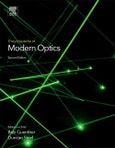The Encyclopedia of Modern Optics, Second Edition, Five Volume Set provides a wide-ranging overview of the field, comprising authoritative reference articles for undergraduate and postgraduate students and those researching outside their area of expertise. Topics covered include classical and quantum optics, lasers, optical fibers and optical fiber systems, optical materials and light-emitting diodes (LEDs). Articles cover all subfields of optical physics and engineering, such as electro-optical design of modulators and detectors. This update contains contributions from international experts who discuss topics such as nano-photonics and plasmonics, optical interconnects, photonic crystals and 2D materials, such as graphene or holy fibers.
Other topics of note include solar energy, high efficiency LED's and their use in illumination, orbital angular momentum, quantum optics and information, metamaterials and transformation optics, high power fiber and UV fiber lasers, random lasers and bio-imaging.
Table of Contents
Cavity Quantum Physics Displays Fiber Optics, Fiber lasers, guided wave devices Holography Lasers Laser Radar Medical Applications Medical and Non-medical Imaging Metamaterials and Plasmonics Microscopes Nano Optics in the Life Sciences Nonlinear Optical Spectroscopy Nonlinear Optics Optical Interconnects Optics of semiconductors and 2d materials Organic Materials Photonics Quantum Information Quantum Optics Transformation Optics








